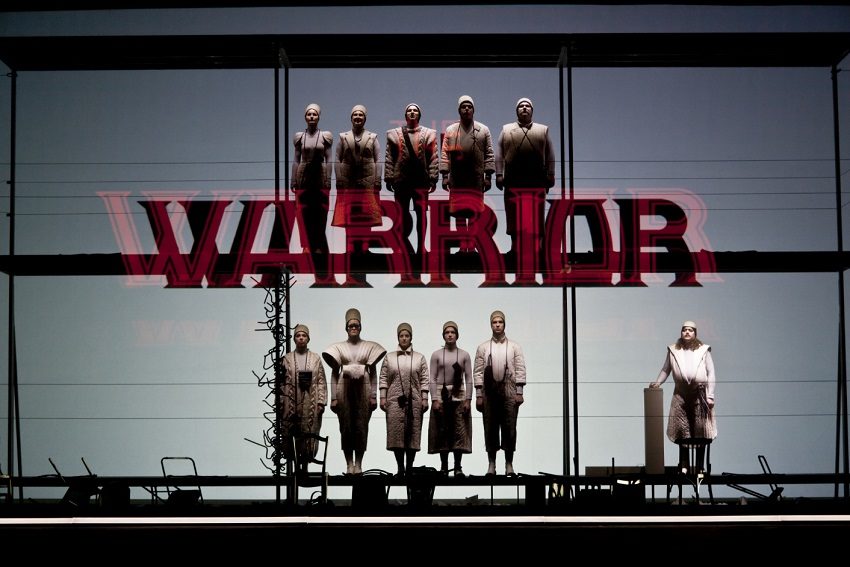Art of war: 'Manga opera' brings war to stage for OzAsia

OzAsia Festival presents the first Australian performance of a powerful new multimedia opera, War Sum Up, premiered in 2011 in Riga, Latvia.
If there is one subject society tends to close its eyes on, because it is just too horrifying, it’s war. The ultimate nightmare, war is nevertheless a constant throughout history, and it creates the most indelible stories.
A show coming up in OzAsia confronts this reality full on. The intriguingly titled War Sum Up seeks neither to glorify war nor make any predictions about how global conflict might be lurking over humanity’s future. Rather, this post-apocalyptic stage work is about how, despite its tragedy upon tragedy, war is a time when people are actually at their most creative: when technology leaps ahead and when thinking and opinions really change.
We see three protagonists acting out different stories of war, while representing different genres, in this unique multimedia production from Denmark. A soldier, warrior and spy each have their experiences on the frontline portrayed graphically and dispassionately.
Kirsten Dehlholm, co-creator of War Sum Up and artistic director of Hotel Pro Forma, which is presenting this show, explains: “The modern soldier, who suffers from PTSD, is killed in a roadside explosion and a monument is raised in honour for him. A warrior who fights for his belief or ideology is killed in the battle. He becomes a ghost and has to tell his story again and again in order to find peace. A female spy from the sci-fi genre escapes from captivity by using her skills in the martial arts. She is transformed into a superwoman and escapes. She is part of the fantasy genre and popular culture.”

Looking on distantly is a yellow-suited Game Master who coolly attempts to plot their fate.
The inspiration for War Sum Up comes from two Japanese sources, Noh theatre and manga art. Fragments of text come via ancient Noh poetry, sung in Japanese (with English surtitles), while manga drawings provide a contemporary iconography of war through depictions of what Dehlholm describes as the man-machine connection.
“The visuals are drawings not from manga but from books called How to Draw Manga,” she says. “Here we found the simple drawings of the human body, of weapons, structures and landscapes. Here we found the way to tell about how man changes to become a machine, a war-machine. The drawings are used as very large front and rear projections.”
Juxtaposing the static and the violent, these drawings by manga artist Hikaru Hayashi show feet, fists and fingers morphing into implements of war. The effect is concentrated and epigrammatic – and a first in the annals of opera.
“War Sum Up is about war,” Dehlholm says. “Not any specific war, but war of our time. War is as simple and as complicated as man itself.”
If this work has a universal message, it is “to stop the war, any war”, she says.
War’s barbaric nature puts it beyond normal comprehension, but Dehlholm believes art can help society towards accepting it: “War is an ever-existing phenomena. It needed to be investigated as a performance.
“The nature of war is ever-changing, adapting to the era’s usable weapons and to the culture within which it takes place. War develops new technology, new strategies, new opinions.”
Dehlholm’s background lies in the visual arts and she has worked with performance art for over 30 years. She founded Hotel Pro Forma in 1985, and has now staged over 80 performances at numerous venues including the Venice Biennale, Berliner Festspiele, Brooklyn Academy of Music and La Monnaie in Brussels.
The show’s co-creator, theatre director Willie Flindt, is a qualified Noh actor and has studied Noh theatre music.
“Willie has studied the old Noh plays and speaks Japanese,” Dehlholm says. “He found the fragments of text from various plays that could be used to describe the emotions of war in different stages, poetic and abstract descriptions. This was to make the description of war more universal.”

Playing the music is UK ‘performance pop orchestra’, The Irrepressibles. Led by flamboyant alt-rock and electronica musician Jamie McDermott, this group charts a new, acoustically-based direction in pop music. McDermott and Latvian composer Santa Ratniece wrote the score for War Sum Up, but were asked to do so without collaborating.
Dehlholm explains: “The two composers were not allowed to work together but each of them got their parts of the libretto for creating the music. They both used electronics, and the final result works very well as one composition.”
We are also lucky to have for this first Australian performance the Latvian Radio Choir, whose wide repertoire extends from early Renaissance and Baroque to contemporary music. Kaspars Putniņš, the choir’s conductor, is a regular guest conductor at the BBC Singers, Netherlands Chamber Choir and the Vocal Ensemble of Stuttgart.
Costumes are designed by Denmark’s Henrik Vibskov, a visual installation artist in opera and theatre and one of the most recognised fashion designers in Scandinavia today.
With its multiple layers and international creative team, how does this opera exactly sum up the awful realities of war?
“Please don’t try to understand the piece,” suggests Dehlholm. “Take it in, let the music and the visuals make the bridge to your emotions.”
War Sum Up
Dunstan Playhouse
Monday, November 5 to Tuesday, November 6
ozasiafestival.com.au